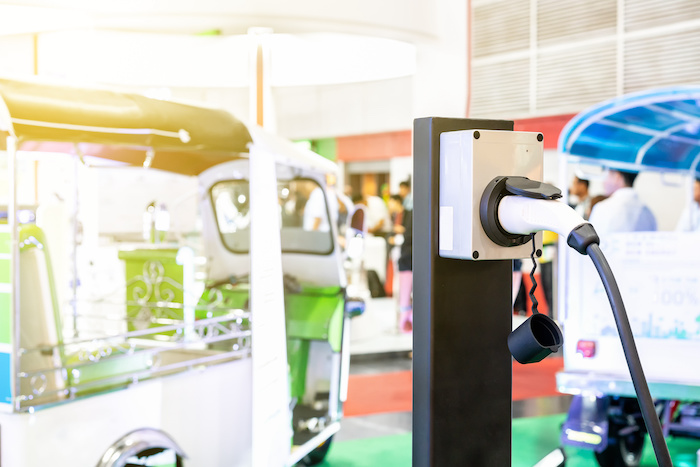From Here to Net Zero: Entrepreneurial Opportunities in Sustainable Transportation

The transportation industry, and the shift to renewable energy, is ripe with opportunities for entrepreneurs and innovators who yearn to help shape a more sustainable future and boost their own fortunes.
In late 2023, more than 200 countries met in Dubai for the United Nations Climate Change Conference (COP28). They made commitments to reduce reliance on fossil fuels and triple capacity in renewable energy by 2030, with the goal of reducing greenhouse gas emissions by 43% and achieving net-zero emissions by 2050.
Despite this monumental worldwide commitment and a growing political will to let go of fossil fuels, significant and complex challenges stand in the way. In this article we outline the opportunities for visionary entrepreneurs and innovators who can find ways to get past those challenges. In particular, we focus on the transportation industry, a significant contributor to CO2 emissions, heavily dependent on fossil fuels.
Where Things Are Now
Along with the historic commitment made at COP28, a significant transformation is already unfolding in the energy landscape. Here are some things that entrepreneurs and innovators should know:
- In 2022, for the first time in history, renewable energy attracted more investment than traditional fossil fuel generation, a decisive pivot toward sustainable energy sources. The financial landscape clearly indicates the direction in which the world is moving, even if public perception has yet to catch up.
- The cost competitiveness of renewable energy is also constantly improving. Coupled with its scalability, this growing affordability positions it as a formidable contender in meeting the world's growing energy demands. A substantial percentage of new global energy capacity now comes from renewable sources.
- The transportation sector is also experiencing a paradigm shift, with electric vehicles (EVs) emerging as frontrunners in the race toward net-zero mobility. According to the International Energy Agency (IEA), nearly 15 million EVs were sold in 2023, a 35% year-on-year increase from a year earlier[1]. In 2022, 8 out of 10 cars sold in Norway were electric[2].
Challenges and Bottlenecks
In the transition to net-zero mobility, a range of significant challenges still require strategic solutions for a comprehensive and widespread shift. While green energy generation has made commendable progress, the current focus now turns to the pragmatic aspects of operationalizing this transformative vision.
The good news is that the cost of EVs is coming down. The Total Cost of Utilization (TCU) for electric vehicles is already lower than for gas-powered cars, since they have fewer moving parts and lower maintenance costs. Without the need for transmissions, fuel tanks, and exhaust systems, these cars can offer more spacious and comfortable interiors as well as lower costs.
Infrastructure availability and reliability remain major challenges. Furthermore, renewable energy supplies, such as wind and solar, fluctuate depending on weather patterns. Energy storage, including batteries, is a crucial element of the solution for this issue. Moreover, when those batteries reach the end of their useful life, a safe path for reusability is necessary.
We also need to seamlessly integrate grids, residences, and vehicles into a unified, interconnected, and reliable ecosystem. This will require a huge investment and strategic coordination. To encourage more people to choose electric vehicles, we also need a charging infrastructure that is convenient, reliable, and widespread so that drivers no longer worry about running out of power while on the road.

Entrepreneurial Opportunities on the Path to Net-Zero Mobility
Amidst the dynamic shift towards net-zero mobility, entrepreneurs stand at the forefront of transformative change, poised to capitalize on a myriad of opportunities that emerge from the need for making mass adoption practical, convenient, and economically viable for all users. As the mobility sector aligns itself with the goals of COP28, entrepreneurs can strategically position themselves in key areas to drive innovation and shape the future of sustainable transportation. Here are the key areas that need innovation, and the companies that are already addressing these challenges.
Charging Infrastructure Development: Entrepreneurs can seize the moment by focusing on the development of a robust charging infrastructure for electric vehicles (EVs). With the increasing demand for EVs, there is a pressing need for innovative solutions in building and expanding charging networks. This includes fast-charging stations strategically located in urban areas and along highways, and innovative charging solutions for remote locations. Innovative companies that have already made an impact in developing charging infrastructure include San Francisco’s Freewire, whose battery-integrated solutions give drivers access to ultra-fast DC (direct current) charging at the grid’s edge, without a high voltage grid connection.
Advanced Battery Technologies: The quest for more efficient and sustainable battery technologies presents another significant opportunity for entrepreneurs and innovators. Investing in research and development of cutting-edge battery systems can position entrepreneurs at the forefront of the EV revolution. This includes exploring innovations in solid-state batteries, energy-dense solutions, regulatory-mandated recycling, and technologies that enhance overall battery performance. We also need more innovation in the field of dry coating for automotive batteries, where major energy savings and reduced environmental manufacturing footprint improvements can be achieved. Companies such as Redwood materials, initiated by Tesla co-founder J. Straubel, are already enabling scalable solutions in the recycling area.
Electric Fleet Management: Entrepreneurs can pioneer solutions in electric fleet management, addressing the needs of businesses and organizations transitioning to electric vehicles. This encompasses software platforms, analytics tools, and efficient management systems that optimize the performance, charging, and maintenance of electric vehicle fleets. Fleet Complete is an example of a UK technology company that provides solutions for fleet management, including electric vehicle fleets. They offer a comprehensive platform that incorporates real-time tracking, analytics, and management tools to optimize the performance and efficiency of fleets. This includes features specifically designed for electric vehicles, such as monitoring battery health, charging optimization, and maintenance scheduling.
Sustainable Urban Planning: The shift towards net-zero mobility demands innovative approaches to urban planning. Entrepreneurs with a focus on sustainable urban planning can play a vital role in designing cities and communities that prioritize electric mobility, public transportation, and cycling infrastructure. Smart city solutions that integrate various modes of sustainable transportation present an exciting frontier for entrepreneurial ventures. One example of a company contributing to sustainable urban planning is Sidewalk Labs, which focuses on developing and implementing smart city solutions to address the challenges of urban living, with an emphasis on sustainability. They work on projects that integrate technology and data to enhance the efficiency of urban infrastructure, transportation, and overall city planning.
Renewable Energy Integration: Entrepreneurs can help integrate renewable energy sources into the charging infrastructure and improve the overall efficiency of the grid. This involves exploring solutions such as solar-powered charging stations and other innovations that harness sustainable energy to power electric vehicles, further enhancing the environmental benefits of EV adoption. The advent of vehicle-to-grid integration, from enabling peak shifting to utility-coordinated demand response, has so far been initiated by technologies and commercial ecosystems developed by software-centric startups such as The Mobility House and Nuuve.
Data Analytics and Software Development: The data generated by electric vehicles and charging infrastructure present opportunities for entrepreneurs in data analytics and software development. Entrepreneurs can create platforms that analyze user behavior, optimize charging schedules, and provide insights to enhance the overall efficiency and user experience in the net-zero mobility ecosystem. Bringing true scalability and, ultimately, reliability of the interface for both drivers and networks in the backend of operating networks is being addressed by some start-ups, including Israel’s Driivz (recently acquired by Vontier Corp).
Education and Awareness Platforms: Entrepreneurs can establish platforms focused on educating consumers and businesses about the benefits of net-zero mobility. This includes apps, websites, and initiatives that raise awareness about sustainable transportation choices, government incentives, and the positive environmental impact of adopting electric vehicles.
As entrepreneurs embrace these opportunities, they not only contribute to the net-zero mobility landscape but also pave the way for a more sustainable and environmentally conscious future. The fusion of innovation, strategic entrepreneurship, and a commitment to sustainability defines the entrepreneurial journey in the era of net-zero mobility.
Conclusion
We are truly in the midst of a transition to net-zero mobility. The investment in green power generation is well underway, marking significant progress. What remains crucial is the development of infrastructure, continuous innovation, and mass adoption. Although the transformation won't be instantaneous, the current moment presents an incredible opportunity for a profound shift in transportation, paving the way towards a sustainable future. The ingenuity of entrepreneurs and innovators, the informed choices of individuals, the commitment of governments, and the availability of financing collectively define this transformative era, showcasing the potential for lasting change in the mobility sector. As we confront these challenges head-on, the imperative is clear: Forging a path to net-zero mobility demands a strategic blend of technological and commercial innovation, infrastructure development, and a user-centric approach.
This era of mobility presents not only challenges but also a symphony of opportunities, inviting all players to contribute to a sustainable and net-zero tomorrow.
Learn More






